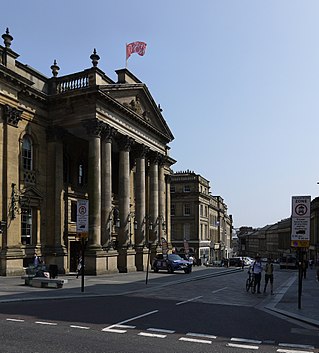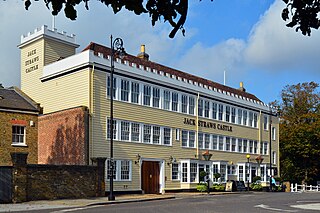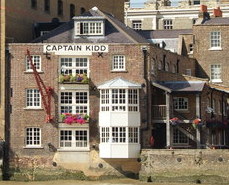
The Bakerloo line is a London Underground line that runs from Harrow & Wealdstone in suburban north-west London to Elephant & Castle in south London, via the West End. Printed in brown on the Tube map, it serves 25 stations, 15 of which are underground, over 23.2 kilometres (14.4 mi). It runs partly on the surface and partly through deep-level tube tunnels.

The Jubilee line is a London Underground line that runs between Stratford in east London and Stanmore in the suburban north-west, via the Docklands, South Bank and West End. Opened in 1979, it is the newest line on the Underground network, although some sections of track date back to 1932 and some stations to 1879.

The Northern line is a London Underground line that runs from North London to South London. It is printed in black on the Tube map. The Northern line is unique on the Underground network in having two different routes through central London, two southern branches and two northern branches. Despite its name, it does not serve the northernmost stations on the Underground, though it does serve the southernmost station at Morden, the terminus of one of the two southern branches.

The Piccadilly line is a deep-level London Underground line running from the north to the west of London. It has two branches, which split at Acton Town, and serves 53 stations. The line serves Heathrow Airport, and some of its stations are near tourist attractions such as Piccadilly Circus and Buckingham Palace. The District and Metropolitan lines share some sections of track with the Piccadilly line. Printed in dark blue on the Tube map, it is the fourth busiest line on the Underground network, with over 210 million passenger journeys in 2011/12.

Fleet Street is a major street mostly in the City of London, England. It runs west to east from Temple Bar at the boundary with the City of Westminster to Ludgate Circus at the site of the London Wall and the River Fleet from which the street was named.

Westminster Bridge is a road-and-foot-traffic bridge over the River Thames in London, linking Westminster on the west side and Lambeth on the east side.

Grainger Town is the historic commercial centre of Newcastle upon Tyne, England. It covers approximately 36 ha. Almost all of Grainger Town is in Newcastle's Central Conservation Area, one of the first designated in England. The area includes a mediaeval 13th-century Dominican friary, pieces of the historic Town Walls, and many fine Georgian and Victorian buildings.
The City University Club is a gentlemen's club in the City of London, established in 1895. From its foundation until 2018 it operated from the top three floors of 50 Cornhill, of what was Prescott's Bank, a 1766 private bank which became a branch of part of the NatWest banking group. This arrangement was quite specifically intended by and between the bank's partners and the club of which they were founding members when the building was designed. The branch closed in 1999 and was turned into a pub of the Fullers chain.

The Punch Bowl, at 41 Farm Street, Mayfair, is a London public house, dating from circa 1750. It is listed as Grade II by English Heritage. It is a Georgian building and, although altered over the years, retains many period features including a dog-leg staircase, internal cornicing and dado panelling.

The building at 155–158 North Street in Brighton, part of the English coastal city of Brighton and Hove, was built between 1921 and 1923 as a branch of National Provincial Bank. The King Louis-style bank was built on the site of several shops. The properties were acquired by the National Provincial Bank during 1916–20. The Brighton Gazette had occupied 155a North Street since 1910, when its long-time home at number 150 was converted into the Cinema de Luxe. Published by William James Towner, the paper’s full title was the Brighton Gazette, Hove Post and Sussex Telegraph. In 2011 it became J D Wetherspoon's second pub in central Brighton. One of many buildings by the prolific local architecture firm of Clayton & Black, whose work in various styles can be found across the city, it forms an important component of the range of banks, offices and commercial buildings on North Street—a significant commercial thoroughfare since the 18th century. In particular, the "good attention to detail" shown throughout the building's Louis XIV-style façade has been praised. English Heritage has listed it at Grade II for its architectural and historical importance.

The Blackfriar is a Grade II* listed public house on Queen Victoria Street in Blackfriars, London.

The Flask is a Grade II listed public house at 14 Flask Walk, Hampstead, London, on the site from where the trade in Hampstead mineral water was run, and which is mentioned in the eighteenth century novel Clarissa. It has been owned by Young's Brewery since 1904.

Hammersmith Fire Station is a Grade II listed building at 244 Shepherd's Bush Road, Hammersmith, London W6 7NL.

Jack Straw's Castle is a Grade II listed building and former public house on North End Way, Hampstead, north-west London, England close to the junction with Heath Street and Spaniards Road.

Ye Olde Cock Tavern is a Grade II listed public house at 22 Fleet Street, London EC4. It is part of the Taylor Walker Pubs group.

The Queen's Head Tavern was located on Fleet Street to the east of the Temple Bar in London. It was already established in 1682 when it is mentioned in the diary of Narcissus Luttrell: "The 2nd, in the morning early, a fire broke out in the back part of the Queen's Head Tavern, by Temple Bar".

The Six Bells is a public house in St Michael's Street in St Albans, Hertfordshire, England. The seventeenth-century timber-framed building is situated within the walls of the Roman city of Verulamium.

The Captain Kidd is a pub in Wapping, East London, that is named after the seventeenth century pirate William Kidd, who was executed at the nearby Execution Dock. The pub is a Grade II listed building, and was historically used as a coffee warehouse.

The Old Bell is a pub at 95 Fleet Street, London EC4.



















